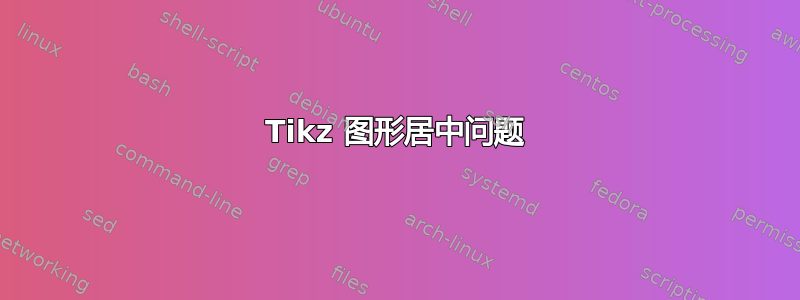
我试图将这个特定的 Tikz 树形图置于我的论文的中心:
我正在使用以下代码:
\begin{center}
\begin{figure}[H]
\begin{forest}
for tree={grow'=0,align=left,l sep=6em,
anchor=center,parent anchor=east,child anchor=west,
edge={semithick,-stealth,shorten >=1em}},
[$x$ (consumer)\\
or
$-x$ (producer),alias=root
[{$u(c)$\\
if consumer\\
},
edge label={node[pos=0.4,above]{$1/2$}},
alias=c1,inner ysep=0pt]
[{$g(y)$\\
if producer\\
},
edge label={node[pos=0.4,below]{$1/2$}},
alias=c2,inner ysep=0pt]
]
\path ([yshift=-1ex]current bounding box.south) coordinate (aux);
\begin{scope}[decoration={calligraphic brace, amplitude=6pt},line width=1pt]
\draw[decorate] (aux-|root.east) --
(aux-|root.west) node[midway,below=1ex]{Day};
\draw[decorate] (aux-|c1.east) --
([xshift=-1ex]c1.west|-aux) node[midway,below=1ex]{Night};
\draw[decorate] (c1.south west) -- (c1.north west);
\draw[decorate] (c2.south west) -- (c2.north west);
\end{scope}
\end{forest}
\caption{The physical environment\label{fig:1}}
\end{figure}
\end{center}
关于如何更改序言以使 Tikz 树形图居中,有什么建议吗?
我的序言:
\documentclass[12pt,letterpaper]{article}
\usepackage[margin=1in]{geometry}
\usepackage[english]{babel}
\usepackage[utf8x]{inputenc}
\usepackage{amsmath}
\usepackage{xfrac}
\usepackage[retainorgcmds]{IEEEtrantools}
\usepackage{graphicx}
\usepackage{tabularx}
\usepackage{subfig}
\usepackage{float}%keeps figures in the text where the page the code is written
\usepackage{pgfplots}
\usepackage{tikz}
\tikzset{
mybox/.style={rounded rectangle,draw=black,align=center},
}
\usetikzlibrary{backgrounds,intersections}
\usetikzlibrary{positioning,shapes.misc}
\usepackage[edges]{forest}
\usetikzlibrary{decorations.pathreplacing,calligraphy}
\usetikzlibrary{arrows.meta,
positioning,
quotes,
shadows, shapes.misc}
%Fonts
%\usepackage{times}
%\usepackage{kpfonts} % for nice fonts
%\usepackage{times}
\usepackage{setspace}
\usepackage{microtype}
\usepackage{booktabs} % for nice tables
\usepackage{multirow} % tables feature
\usepackage[flushleft]{threeparttable}
\usepackage{array}%position table cell text
%\usepackage{bbold} % for bold math
\usepackage{dsfont}
\usepackage{listings} % for inserting code
\usepackage{verbatim} % useful for program listings
\usepackage{color}
\usepackage[colorlinks=true, linkcolor=blue, urlcolor=blue, citecolor=blue]{hyperref}
% use for hypertext
\usepackage[colorinlistoftodos]{todonotes}%used to add notes on PDF
%\usepackage{natbib}
%\bibpunct{(}{)}{;}{;}{,}{,}
\usepackage[colon]{natbib}%package for bibliography
\setcounter{secnumdepth}{3} %the depth of section numbering 0 means no numbering of any section, sub-section and on.
%used for begining theorems and propostions numbered according to the section they are in
\newtheorem{theorem}{Theorem}[section]
\newtheorem{corollary}{Corollary}[theorem]
\newtheorem{lemma}[theorem]{Lemma}
\newtheorem{proposition}[theorem]{Proposition}
\newtheorem{assumption}[theorem]{Assumption}
\newtheorem{definition}[theorem]{Definition}
\usepackage{pdflscape}
\usepackage{afterpage}
\usepackage{capt-of}
\setlength{\parskip}{1em}
\usepackage{amssymb}
%% Shortcuts
\newcommand{\td}[2]{\dfrac{d #1}{d #2}}
\newcommand{\std}[2]{\dfrac{d^2 #1}{d {#2}^2}}
\newcommand{\ctd}[3]{\dfrac{d^2 #1}{d #2 d #3}}
\newcommand{\pd}[2]{\dfrac{\partial #1}{\partial #2}}
\newcommand{\spd}[2]{\dfrac{\partial^2 #1}{\partial {#2}^2}}
\newcommand{\cpd}[3]{\dfrac{\partial^2 #1}{\partial #2 \partial #3}}
\newcommand{\pdi}[2]{\partial #1/\partial #2}
\newcommand{\LR}{\Leftrightarrow}
\newcommand{\Lg}{\mathcal{L}}
\newcommand{\half}{\tfrac{1}{2}}
\newcommand{\eqp}{\phantom{=}}
\newcommand{\eqs}{\buildrel s \over =}
\newcommand{\me}{\mathrm{e}}
\makeatletter
\newcommand*\rel@kern[1]{\kern#1\dimexpr\macc@kerna}
\newcommand*\widebar[1]{%
\begingroup
\def\mathaccent##1##2{%
\rel@kern{0.8}%
\overline{\rel@kern{-0.8}\macc@nucleus\rel@kern{0.2}}%
\rel@kern{-0.2}%
}%
\macc@depth\@ne
\let\math@bgroup\@empty \let\math@egroup\macc@set@skewchar
\mathsurround\z@ \frozen@everymath{\mathgroup\macc@group\relax}%
\macc@set@skewchar\relax
\let\mathaccentV\macc@nested@a
\macc@nested@a\relax111{#1}%
\endgroup
}
\makeatother
\begin{document}
答案1
像这样:
(红线表示文本边框区域)
正如我在评论中所说:有史以来较新的在固定环境中插入浮动环境(figure, )table\begin{center} ) ...\end{center}. 你应该这样写:
\begin{figure}[ht]
\begin{center}
\begin{forest}
...
\end{forest}
\end{center}
\end{figure}
然而,更好的方法是使用\centering之后的命令\begin{figure}[...],因为它不会在图像周围引入额外的垂直空间。
完整的 MWE(仅带有必要的前言)显示您的树形图,如下所示:
\documentclass[12pt,letterpaper]{article}
\usepackage[margin=1in]{geometry}
\usepackage[english]{babel}
\usepackage[edges]{forest}
\usetikzlibrary{arrows.meta,
decorations.pathreplacing,calligraphy,
positioning,
quotes,
shadows, shapes.misc}
\usepackage{microtype}
\begin{document}
\begin{figure}[ht]
\centering
\begin{forest}
for tree={grow'=0,align=left,l sep=6em,
anchor=center,parent anchor=east,child anchor=west,
edge={semithick,-stealth,shorten >=1em}},
[$x$ (consumer)\\
or
$-x$ (producer),alias=root
[{$u(c)$\\
if consumer\\
},
edge label={node[pos=0.4,above]{$1/2$}},
alias=c1,inner ysep=0pt]
[{$g(y)$\\
if producer\\
},
edge label={node[pos=0.4,below]{$1/2$}},
alias=c2,inner ysep=0pt]
]
\path ([yshift=-1ex]current bounding box.south) coordinate (aux);
\begin{scope}[decoration={calligraphic brace, amplitude=6pt},line width=1pt]
\draw[decorate] (aux-|root.east) --
(aux-|root.west) node[midway,below=1ex]{Day};
\draw[decorate] (aux-|c1.east) --
([xshift=-1ex]c1.west|-aux) node[midway,below=1ex]{Night};
\draw[decorate] (c1.south west) -- (c1.north west);
\draw[decorate] (c2.south west) -- (c2.north west);
\end{scope}
\end{forest}
\caption{The physical environment\label{fig:1}}
\end{figure}
\end{document}




